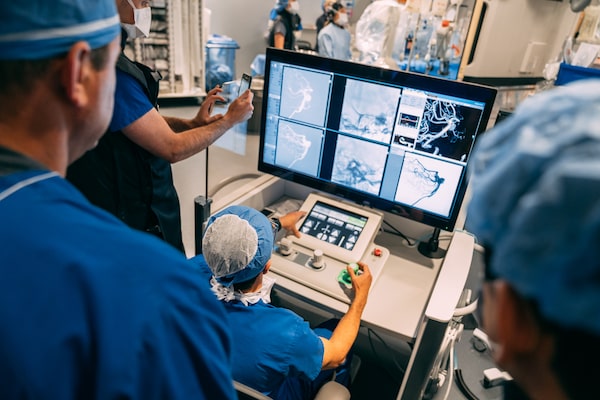
The team at the University Health Network guided a robot Friday to place a stent and 14 coils deep inside the brain of a 64-year-old woman to treat an aneurysm.Krembil Brain Institute/UHN
Toronto doctors have performed their first robot-assisted brain surgery on a live patient, testing a system they believe will allow them to operate remotely on stroke and aneurysm patients in the near future.
The team at the University Health Network guided a robot Friday to place a stent and 14 coils deep inside the brain of a 64-year-old woman to treat an aneurysm. The procedure demonstrated the ability to use the system to treat the delicate vessels of the brain.
“This is important because the robotic system brings a lot of precision and control to these procedures,” said Vitor Pereira, a neurosurgeon and neuroradiologist with the Krembil Brain Institute at Toronto Western Hospital. “It opens the door to do remote procedures … in communities [where] they don’t have this type of treatment and don’t have the personnel to perform these procedures too.”
Surgical robots are used routinely in the United States and in some Canadian hospitals for various procedures, including knee replacements and prostate and heart surgeries. But it has taken more time to develop a robotic system nimble enough to navigate the thousands of major vessels in the brain.
The system, developed by Corindus, a company owned by Siemens Healthineers AG, can be used to block blood flow to weak spots on brain vessels, or aneurysms, to prevent a hemorrhage, said Timo Krings, another neurosurgeon and neuroradiologist at Krembil. It can also be used to remove blockages involved in a stroke, he said.
For the latter, timing is critical, as brain cells die at a rate of about two million per minute when the brain is starved of oxygenated blood, Dr. Krings said. He noted that by the time a stroke patient in Thunder Bay, Ont., arrives at his hospital in Toronto, it may be too late to salvage tissue in the affected area of the brain.
“Rather than bringing the patient to the physician … we are having now the opportunity with this robot to bring the physician’s expertise to the patient,” said Dr. Krings, head of the department of neuroradiology.
During Friday’s procedure, while doctors were at the patient’s bedside, Dr. Pereira operated the system’s robotic arms from a console several metres away.
The doctors first made a small puncture in the patient’s leg and threaded a catheter through her femoral artery up to her neck, which is how they typically perform the procedure. But from there, using an X-ray for guidance, they controlled the robotic system to lead the catheter into her brain, where it placed the stent and coils.
In an aneurysm, the weakened wall of the blood vessel forms a blister, which may rupture, Dr. Pereira said. In the case of this patient, the aneurysm was detected a couple of weeks earlier through magnetic resonance imaging, after she saw a neurologist for her headaches.
The coils prevent blood flow to the aneurysm, and over time a new layer of cells reconstructs the vessel without an aneurysm, Dr. Pereira said.
He said the procedure took about 2½ hours. The patient was discharged the following day and was doing well.
He and Dr. Krings said the team may consider performing a fully remote procedure next year.
At the Ottawa Hospital, stroke neurologist Dar Dowlatshahi, who was not involved in the procedure, said the potential for using surgical robots to perform remote neurovascular therapies would have a great impact in countries like Canada, with a limited number of specialists and a population spread over a vast area.
“When you’re dealing with very rare, super-specialized experts in the neurovascular field – stroke physicians and stroke radiologists, these are in very short supply,” Dr. Dowlatshahi said. “So I think there’s going to be a lot more opportunity and advantages [to the use of robotic systems] than there will be challenges.”
There are limitations, however. The system can still only do the intracranial part of a procedure, which means someone still needs to be present to do all the preparation work, including putting in the catheter, Dr. Pereira said.
Dr. Krings added that the system requires special training to operate.
“With time and with more experience, we will get better and way more accustomed to this new type of treatment,” he said. “But it’s important to realize it’s just one tool in the toolbox. It’s not that this will now change everything for every single procedure that we’re doing.”
Our Morning Update and Evening Update newsletters are written by Globe editors, giving you a concise summary of the day’s most important headlines. Sign up today.
 Wency Leung
Wency Leung